仁爱版英语八年级下册教案全集(详细)(1)
- 格式:doc
- 大小:7.12 MB
- 文档页数:52
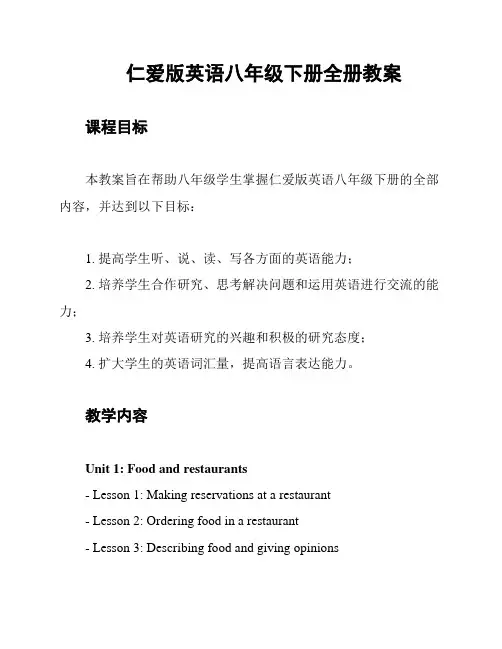
仁爱版英语八年级下册全册教案课程目标本教案旨在帮助八年级学生掌握仁爱版英语八年级下册的全部内容,并达到以下目标:1. 提高学生听、说、读、写各方面的英语能力;2. 培养学生合作研究、思考解决问题和运用英语进行交流的能力;3. 培养学生对英语研究的兴趣和积极的研究态度;4. 扩大学生的英语词汇量,提高语言表达能力。
教学内容Unit 1: Food and restaurants- Lesson 1: Making reservations at a restaurant- Lesson 2: Ordering food in a restaurant- Lesson 3: Describing food and giving opinionsUnit 2: Travel- Lesson 1: Planning a trip- Lesson 2: Asking for and giving directions- Lesson 3: Talking about past travel experiencesUnit 3: Environment- Lesson 1: Talking about environmental problems- Lesson 2: Describing places and giving directions- Lesson 3: Talking about actions to protect the environmentUnit 4: Jobs and career choices- Lesson 1: Talking about different jobs- Lesson 2: Discussing career choices and aspirations- Lesson 3: Writing a resumeUnit 5: Health and fitness- Lesson 1: Talking about healthy lifestyle habits- Lesson 2: Discussing different sports and activities- Lesson 3: Talking about health issues and giving advice教学方法为了达到上述目标,我们将采用以下教学方法:1. 视听法:播放相关的英语听力材料,逐步提高学生的听力理解能力。

6.Volunteers read the phonetics.7.Students correct their pronunciation while the teacher is reading.& Students read the phonetics and the given words in 4a and say the rules for spelling・9.Students read the words on the cards・10.Read the sentences in the box in 4b・11.Students read after the teacher.12.Students finish 4b in pairs and practice it with their partners.Step 51 ・ Students act out the conversation of la in groups of four2.Think about and say out linking verbs and adjectives as many as possible・3.Students sum up the main points.4.Students finish their homework after class.(1)Make up sentences・(2)Memorize the summaiy after class.(3)Search tlie information about the movie,The Sound of Music.(4)Prcvicw Section C Students understand the structure of "linking verb + adjective” well and they can make up right sentences with it. But they need more exercises about the usages of adjectives ended with -ed and -ing. They are very interested in the movie The Sound of Music after learning Section A and B.ITs helpful for them to learn Section C. VII.Blackboard designUnit 5 Feeling Excited Topic 1 You look excited・ Section B1. seem unhappy G1 G2 G3 G4feel disappointed 2 4 1 2be interesting/ fun 3 2 2 2be boring 1 2 2 3be exciting2. Great! He must be excited to get it.news right now!OK. I will tell him theexcitingUnit 5 Feeling ExcitedTopic 1 You look excited.Section CI ・ Material analysis本节课建议用一课时完成,主要活动为la和2a。

仁爱版英语八年级下册英语教案5篇仁爱版英语八年级下册英语教案篇1教学目标一、知识与技能1. 复习、巩固表示委婉请求和应答的句型。
2. 培养阅读理解能力。
3. 完成相关练习。
二、过程与方法将抽象知识具体化,帮助学生总结规律,系统地学习语法。
调动学生的积极性,引导他们积极参与课堂。
三、情感态度与价值观认识到做家务的意义和重要性,养成常做家务的好习惯。
教学重点复习、巩固表示委婉请求和应答的句型。
教学难点培养阅读理解能力。
教法导航通过大量练习让学生主动掌握语法知识。
学法导航练习、讨论、主动探求规律。
教学准备多媒体。
教学过程Step 1 GreetingsGreet the students as usual.Step 2 A GameShow a list of chores on the blackboard:do the dishes clean your roomtake out the trash sweep the floorfold your clothes make your bedGive them a set of blank cards.T:Let’s play a game. You will work in groups of four. First each group writes the chores on the cards. Put them face down. The first student turns over a card,and asks the student next to him/her to do this chore. That student says “no” and gives a reason. Each student should give a reason that has not been given before. The one who can’t give a proper reason will be out of the game. Those who can keep coming up with reasons will be the winner.Step 3 Role playAsk some pairs to role play the dialogue in 2d.Step 4 PresentationSay:As we all know,Mother does almost all the housework in the house. She is always tired. Should we help Mother? What we can do to help her? Ask some students to report their answers.Step 5 ReadingSay:Now let’s read an article about Nancy and her mother. Please read quickly and answer the questions:1. Why was Nancy’s mom angry with her? 2. Did they solve the problem? How?Then ask some students to report their answers.Now let’s read the sentences in 3b,try to understand and translate them. Then read the passage again carefully and try to underline the sentences from the reading that mean the same thing. After several minutes, ask some students to report their answers and translate the sentences into Chinese.Step 6 Language points1. You watch TV all the time and ...all the time(在该段时间内)一直;向来,一向;时时刻刻;每时每刻e.g. I do this all the time. 我一直是这么做的。

仁爱版英语八年级下学期教案Unit 5 Topic?1 Section?ASection A需用1~2课时。
重点活动是1,2和3。
教学目标:1.能听懂谈论个人情感的比较熟悉的话题,获取主要信息。
2.掌握be+adj. 的用法。
教学过程:第一步:复习师生问候。
谈谈寒假生活及过春节的感受。
如:Teacher: How are you? / How are you doing?Student1: Fine,thanks!Teacher: You look so happy, why?Student1: I come back to school again, so I’m glad to see my classmates.Teacher: Did you have a good winter holiday?Student2:Yes,I did.Teacher: How about your Spring Festival?Student2:I had a wonderful Spring Festival. I got...Teacher: Why all the smiling faces?Students: Because today is the first day of this term...第二步:呈现1.在师生对话之后,老师板书呈现课题。
Unit 5 Topic 1 (内容)2.之后老师总结:We are all happy today.老师提问:What about Kangkang and Michael?放录音1,请同学们听录音并从所听对话中找到答案:Kangkang looks excited.Michael is happy.3.打开课本,请同学们跟读1的对话,师生共同检查答案,教师同时在黑板上写出关键词、句:How are you doing? —excited—tickets—want—The Sound of Music—spend—happy—say thanks to4.学生看着关键词,分组进行对话,让学生试着表演对话。

Unit 5 Feeling ExcitedTopic 1 You look excited.Section AⅠ. Teaching aimsKnowledge aims:1. 学生能正确拼读并运用以下词汇:(1)单词表中的黑体单词invite(2)连系动词:be,look, feel, taste, smell和sound(3)描述情绪的形容词:excited, happy和disappointed2. 学生能正确运用以下短语造句:invite sb. to do sth.prepare sth. for sb.say thanks/ goodbye /hello/sorry to sb.a ticket to …3. 学生能自如地运用以下功能句进行交流:How are you doing? Very well, thank you.Guess what!What a pity!Skill aims:1. 能听懂有关情绪的询问与表达的简单对话和陈述。
2. 能正确地运用本课的交际功能用语问候或表达情绪。
3. 能正确朗读课本的有关情绪描述的文本材料及难度相当的材料。
4. 能正确地运用本课连系动词加形容词作表语的语法结构,以及交际功能语言写出简单的问候和询问情绪的对话。
Emotional aims:通过对Section A的学习,学生能够在学会描述和表达自己情绪的同时,学会控制不利于自身的消极情绪,并且能够学会关注他人的情绪,在别人情绪低落时主动帮助排解不良的情绪,互助互爱。
Ⅱ. The key points and difficult pointsKey points:学生在交流中能自如地运用系表结构和以下短语:invite sb. to do sth.prepare sth. for sb.say thanks/ goodbye /hello/sorry to sb.a ticket to …Difficult points:1. 学生对功能用语How are you doing? 的理解。
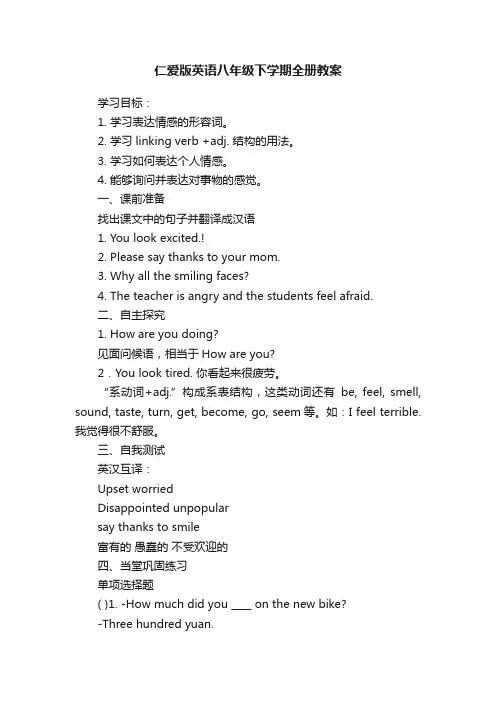
仁爱版英语八年级下学期全册教案学习目标:1. 学习表达情感的形容词。
2. 学习linking verb +adj. 结构的用法。
3. 学习如何表达个人情感。
4. 能够询问并表达对事物的感觉。
一、课前准备找出课文中的句子并翻译成汉语1. You look excited.!2. Please say thanks to your mom.3. Why all the smiling faces?4. The teacher is angry and the students feel afraid.二、自主探究1. How are you doing?见面问候语,相当于How are you?2.You look tired. 你看起来很疲劳。
“系动词+adj.”构成系表结构,这类动词还有be, feel, smell, sound, taste, turn, get, become, go, seem等。
如:I feel terrible. 我觉得很不舒服。
三、自我测试英汉互译:Upset worriedDisappointed unpopularsay thanks to smile富有的愚蠢的不受欢迎的四、当堂巩固练习单项选择题( )1. -How much did you ____ on the new bike?-Three hundred yuan.A. payB. costC. takeD. spend( )2. -Mike felt sad because he failed his exam yesterday.-I’m sorry to hear that. Let’s ____.A. cheer him onB. cheer on himC. cheer him upD. cheer up him( )3. -What’s the matter with T om? He seems ____ sad.-His pet dog died.A. feelB. feelsC. to feelD. feeling( )4. -Shall we go hiking this weekend?-OK. Sounds ____.A. goodB. wellC. good ideaD. bad()5. We have won the basketball game, we’re becoming __________.A. disappointedB. sillyC. richD. excitedSection B学习目标:5. 学习表达情感的单词和短语。

仁爱版八年级下册英语全册教案Unit 5 Feeling ExcitedTopic 1 You look excited.Section AⅠ. Teaching aimsKnowledge aims:1. 学生能正确拼读并运用以下词汇:(1)单词表中的黑体单词invite(2)连系动词:be,look, feel, taste, smell和sound(3)描述情绪的形容词:excited, happy和disappointed2. 学生能正确运用以下短语造句:invite sb. to do sth.prepare sth. for sb.say thanks/ goodbye /hello/sorry to sb.a ticket to …3. 学生能自如地运用以下功能句进行交流:How are you doing? Very well, thank you.Guess what!What a pity!Skill aims:1. 能听懂有关情绪的询问与表达的简单对话和陈述。
2. 能正确地运用本课的交际功能用语问候或表达情绪。
3. 能正确朗读课本的有关情绪描述的文本材料及难度相当的材料。
4. 能正确地运用本课连系动词加形容词作表语的语法结构,以及交际功能语言写出简单的问候和询问情绪的对话。
Emotional aims:通过对Section A的学习,学生能够在学会描述和表达自己情绪的同时,学会控制不利于自身的消极情绪,并且能够学会关注他人的情绪,在别人情绪低落时主动帮助排解不良的情绪,互助互爱。
Ⅱ. T he key points and difficult pointsKey points:学生在交流中能自如地运用系表结构和以下短语:invite sb. to do sth.prepare sth. for sb.say thanks/ goodbye /hello/sorry to sb.a ticket to …Difficult points:1. 学生对功能用语How are you doing? 的理解。

第1篇教学目标:1. 知识目标:学生能够掌握以下单词和短语:sick, hurt, headache, stomachache, fever, medicine, hospital, doctor, take medicine, go to the hospital, see a doctor等。
2. 能力目标:学生能够运用所学词汇和句型进行简单的日常对话,表达自己的病情。
3. 情感目标:培养学生关爱他人、关注健康的意识。
教学重点:1. 掌握生词和短语。
2. 学会运用句型进行询问和回答。
教学难点:1. 询问和回答病情时的语序和语法。
2. 学会使用正确的语气和表情。
教学过程:一、导入1. 教师用图片或视频展示不同的人在不同场合生病的样子,引导学生思考:当别人生病时,我们应该怎么做?2. 学生自由讨论,分享自己的观点。
二、新课呈现1. 教师用PPT展示本节课的生词和短语,引导学生跟读。
2. 教师用例句解释生词和短语的意义,并让学生模仿跟读。
3. 教师用情景对话的方式,展示本节课的句型,如:- What's the matter with you?- I have a headache.- Do you have a fever?- I need to take medicine.4. 学生分组进行角色扮演,练习询问和回答病情。
三、巩固练习1. 教师出示一张图片,要求学生用所学词汇和句型描述图片中人物的病情。
2. 学生分组进行练习,互相检查和纠正。
3. 教师随机抽取学生进行展示,给予评价和鼓励。
四、课堂小结1. 教师引导学生回顾本节课所学内容,强调重点单词和短语。
2. 学生分享自己在学习过程中的收获和困惑。
五、课后作业1. 学生用所学词汇和句型写一篇关于生病的日记。
2. 学生向家人或朋友询问病情,并用所学词汇和句型进行交流。
教学反思:本节课通过图片、视频和情景对话等多种形式,帮助学生掌握生词和短语,学会运用句型进行询问和回答病情。
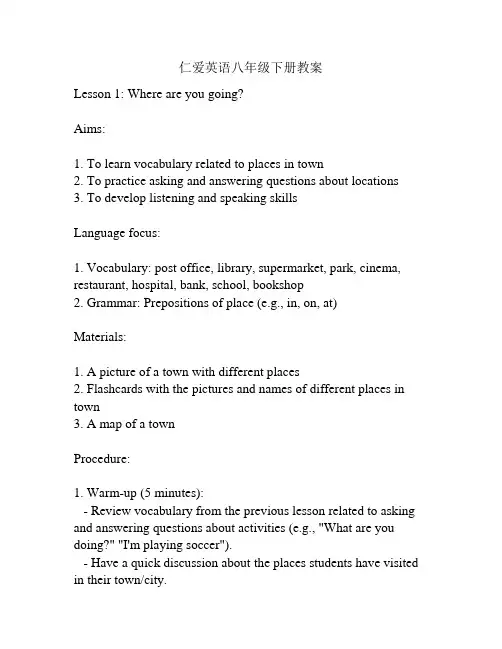
仁爱英语八年级下册教案Lesson 1: Where are you going?Aims:1. To learn vocabulary related to places in town2. To practice asking and answering questions about locations3. To develop listening and speaking skillsLanguage focus:1. Vocabulary: post office, library, supermarket, park, cinema, restaurant, hospital, bank, school, bookshop2. Grammar: Prepositions of place (e.g., in, on, at)Materials:1. A picture of a town with different places2. Flashcards with the pictures and names of different places in town3. A map of a townProcedure:1. Warm-up (5 minutes):- Review vocabulary from the previous lesson related to asking and answering questions about activities (e.g., "What are you doing?" "I'm playing soccer").- Have a quick discussion about the places students have visited in their town/city.2. Presentation (10 minutes):- Show the picture of a town and elicit the names of different places in town from the students.- Introduce new vocabulary using flashcards and model the pronunciation and meaning of each word.- Drill the vocabulary with the whole class and individually.3. Practice (15 minutes):- Divide the class into pairs or small groups.- Give each group a map of a town and ask them to take turns asking and answering questions about the locations on the map using the new vocabulary (e.g., "Where is the post office?" "It's next to the supermarket.").- Monitor the students and provide feedback and assistance as needed.4. Listening (10 minutes):- Play an audio recording of a conversation where two people are asking and answering questions about locations in a town.- Ask students to listen and write down the names of the places mentioned in the conversation.- Play the recording again for students to check their answers.- Discuss the answers as a class.5. Production (10 minutes):- Ask students to work in pairs and create their own conversations asking and answering questions about locations in a town.- Encourage them to use the new vocabulary and prepositions ofplace.- Monitor and provide feedback and assistance as needed.6. Wrap-up (5 minutes):- Review the new vocabulary and prepositions of place with the whole class.- Make sure students can ask and answer questions about locations confidently.Homework:- Ask students to write a short paragraph (around 5-6 sentences) describing their favorite place in their town/city using the new vocabulary and prepositions of place.。
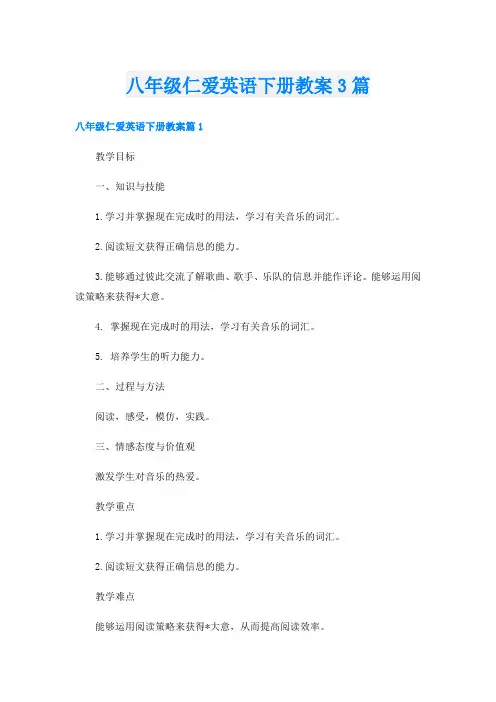
八年级仁爱英语下册教案3篇八年级仁爱英语下册教案篇1教学目标一、知识与技能1.学习并掌握现在完成时的用法,学习有关音乐的词汇。
2.阅读短文获得正确信息的能力。
3.能够通过彼此交流了解歌曲、歌手、乐队的信息并能作评论。
能够运用阅读策略来获得*大意。
4. 掌握现在完成时的用法,学习有关音乐的词汇。
5. 培养学生的听力能力。
二、过程与方法阅读,感受,模仿,实践。
三、情感态度与价值观激发学生对音乐的热爱。
教学重点1.学习并掌握现在完成时的用法,学习有关音乐的词汇。
2.阅读短文获得正确信息的能力。
教学难点能够运用阅读策略来获得*大意,从而提高阅读效率。
教法导航激励学生认真阅读,认真思考。
学法导航通过阅读,模仿学习新知识。
教学准备图片,多媒体。
教学过程Step 1 GreetingsGreet the students as usual.Step 2 Warming upShow some pictures about singers and musicians. Ask and answer:Who is your favorite singer or musician? Why do you like him or her?Step 3 New wordsLearn the new words:pop,rock,band.The students read the words one by one. Then they have a dictation.Step 4 ListeningThe students go through the sentences in 1b.1b, Listen to a conversation between Alex and Dave. Write A for Alex and D for Dave next to each opinion.____ The Toms must be popular.____ The Toms play pop music.____ The Toms’ music sounds more like rock.____ Listening to The Toms is a good way to wake up.1c, Listen again. Take notes.Listen for a third time and check the answers.Step 5 Speaking1d, Ask your friends and parents what kind of music they listen to and why. How does the music make them feel?Ask the students to make a conversation like:A:What kind of music do you listen to?B:I listen to pop music.A:Why do you listen to it?B:I like it because….A:How does the music make them feel?B:It makes me relaxed.Step 6 Discussion Reading2a, Discuss the questions with a partner.1.Do you have a favorite singer or band?2. Do you have a favorite song?3. What facts do you know about your favorite singer,band or song?Reading guidance:1. Read the passage and make notes or underline the main idea of the text.2. After reading,write a short summary in your own words.在讨论的过程中,教授新单词。
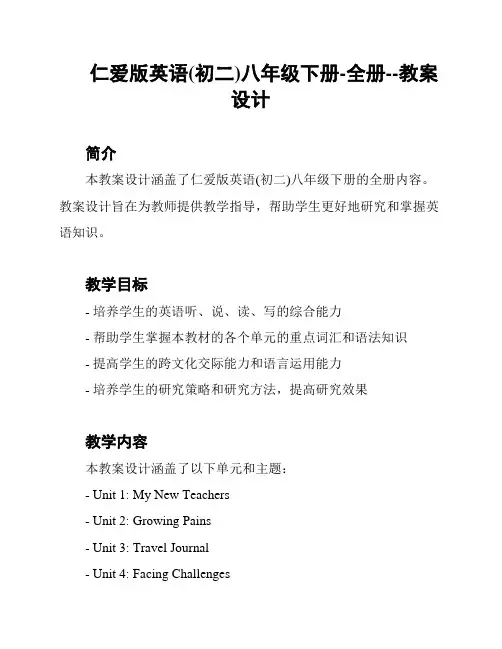
仁爱版英语(初二)八年级下册-全册--教案设计简介本教案设计涵盖了仁爱版英语(初二)八年级下册的全册内容。
教案设计旨在为教师提供教学指导,帮助学生更好地研究和掌握英语知识。
教学目标- 培养学生的英语听、说、读、写的综合能力- 帮助学生掌握本教材的各个单元的重点词汇和语法知识- 提高学生的跨文化交际能力和语言运用能力- 培养学生的研究策略和研究方法,提高研究效果教学内容本教案设计涵盖了以下单元和主题:- Unit 1: My New Teachers- Unit 2: Growing Pains- Unit 3: Travel Journal- Unit 4: Facing Challenges- Unit 5: Inventions- Unit 6: Heroes Around Us- Unit 7: Environment Matters- Unit 8: Fun Time每个单元的教学内容包括以下方面:- 词汇研究- 语法讲解- 听力练- 口语练- 阅读理解- 写作练教学方法- 多媒体教学:使用多媒体资源呈现教学内容,使学生更直观地理解和掌握知识。
- 互动教学:通过小组合作、角色扮演等方式,激发学生的研究兴趣,提高研究效果。
- 情景教学:结合实际情景,设计相关的教学活动,帮助学生更好地运用所学知识。
- 微课教学:利用微课等在线研究资源,提供研究资料和练题,帮助学生自主研究和巩固知识。
教学评估- 课堂表现评估:通过观察学生在课堂上的发言和互动情况,评估学生的口语表达和交流能力。
- 作业评估:通过批改学生的作业,评估学生的阅读理解和写作能力。
- 测验评估:每个单元结束后,进行相关知识的测验,评估学生对所学内容的掌握情况。
教学资源教案设计中所需的教学资源包括:- 课本和教辅材料- 多媒体设备和资源- 微课和在线研究资源教学安排具体的教学安排可根据学校的课程计划和教学需求进行灵活调整。
总结本教案设计致力于通过多种教学方法和资源,帮助学生全面提高英语综合能力。
仁爱版英语八年级下册整册教案Unit6 Enjoying CyclingTopic 1 We’re going on a spring field tripSection A说课稿一、说教材1. 教材分析仁爱版初中英语教材共六册,每册由四个模块组成,每个模块由单元-———话题————功能——-任务构成,编写思路清晰,符合学生的认识发展规律.八年级英语下册第六单元Topic1 Section A讲述了让学生学习如何用英语谈论旅游,并收集旅游信息。
它由3部分组成,用1课时完成。
通过学习Section A,学生可以更多的了解旅游知识并提高实际能力;动词不定式是本节课的重点语法项目。
2.教学目标(1).知识目标要求学生牢记Section A所有新学的四会单词.短语和重点句型;掌握不定式“to do"的用法。
(2).技能目标:能用英语与他人谈论关于旅游的话题。
培养学生提高语言交际能力,能在小组中积极与他人协作,从而开阔自己的视野,扩大知识面.(3).情感目标培养学生爱护大自然,热爱旅游.积极参与课堂上各种英语实践活动的兴趣.培养学生分工合作和团体协作精神.3.教学重点和难点(1)。
重点:谈论关于旅游的话题。
(2)。
重点和难点:不定式“to do”的用法。
二。
说学情1.学生对旅游较感兴趣,但对旅游知识了解较少.2。
学生的词汇量掌握不多.3. 学生平时较少用英语与他人交谈并表达信息..三。
说教法学法按照课程改革的要求,遵循“老师由主演变导演,学生由配角变主角”的角色转换,采用把课堂交给学生的教学理论,我运用自由讨论。
分组工作.结对练习。
问答练习等方法,借助多媒体、录音机,图片等教学手段,设置特定的语言环境,使学生在轻松愉快的气氛中理解.运用英语。
四.说教学程序我设计了以下的步骤来训练学生的听.说。
读。
写的能力,尤其是他们“说”的能力。
(一)温故知新(1).请两位学生用上节课重点句型号,分别复述Unit 5 Topic3 Section D 1a(2).教师与学生之间进行问答对话,让学生谈论关于他们最喜爱的旅游方式.设计意图:巩固上节课学过的知识,为学习新课铺垫.(二)情景导入用多媒体展示一些关于旅游和交通的图片,来引起学生的兴趣,并由此教学本节课的新单词,如:field ,trip ,cycle ,vehicle ,airline等。
仁爱版八年级下册英语教案大全5篇仁爱版八年级下册英语教案大全5篇英语教案可以给英语教师带来更多的反思,可以更好地促进教师的专业成长与发展。
下面是小编为你准备的仁爱版八年级下册英语教案,快来借鉴一下并自己写一篇与我们分享吧!仁爱版八年级下册英语教案精选篇1一、指导思想与教学总目标以“英语课程标准”为宗旨,适应新课程改革的需要,面向全体学生,提高学生的人文素养,增强实践能力和创新精神。
正确把握英语学科特点,积极倡导合作探究的学习方式。
培养学生积极地情感态度和正确的人生价值观,提高学生综合素质为学生全面发展和终身发展奠定基础。
要求学生有较明确的英语学习动机和积极主动的学习态度。
能听懂教师对有关熟悉话题的陈述并能参与讨论。
能读供七至八年级学生阅读的简单读物和报纸杂志,克服生词障碍,理解大意。
能根据阅读目的运用适当的阅读策略。
能与他人合作,解决问题并报告结果,共同完成学习任务。
能在学习中互相帮助,克服困难。
能合理计划和安排学习任务,积极探索适合自己的学习方法。
在学习和日常交际中能注意到中外文化的差异。
二、教材简要分析八年级英语下册共十个单元,每单元设计一个话题,并以此为中心,通过语言结构、功能项目为主线展开,采用任务型语言教学方式,以循序渐进的生活化的学习程序引导学生学会运用英语,有目的地做事。
新教材中设计了许多活动,如填写问卷、调查、访谈、书信、邮件往来等,使学生在语言学习中更好地体验、实践、参与、合作与交流,同时增加了学生在课堂上的互动,为任务型教学创造了条件。
同一话题随着学习的深入,内容不断充实,通过“滚动”呈现学习,不断深化。
如提建议话题,在七年级出现,在本教材Unit8也“滚动”呈现,支持话题的“任务”、“活动”也不断“升级”,伴随语言学习不断从“低级”走向“高级”,贯穿于教材始终。
此外,教材中每个单元设计的Pairwork、Groupwork、Survey及Game为课堂活动提供了丰富的资源。
八年级仁爱英语下册教案教案标题:《八年级仁爱英语下册教案》教案目标:1. 通过本单元的学习,学生将能够掌握并运用本单元的重点词汇和短语。
2. 学生将能够听懂并理解与本单元主题相关的对话和文章。
3. 学生将能够流利地表达自己的观点和意见,并能够用英语进行简单的书面表达。
教学重点:1. 本单元的重点词汇和短语的掌握和运用。
2. 听力技能的培养,能够听懂并理解与本单元主题相关的对话和文章。
3. 口语表达能力的提高,能够流利地表达自己的观点和意见。
4. 书面表达能力的培养,能够用英语进行简单的书面表达。
教学难点:1. 听力技能的培养,学生能否听懂并理解与本单元主题相关的对话和文章。
2. 口语表达能力的提高,学生能否流利地表达自己的观点和意见。
3. 书面表达能力的培养,学生能否用英语进行简单的书面表达。
教学准备:1. 教材《八年级仁爱英语下册》2. 多媒体设备3. 课堂活动所需的教具和材料教学步骤:Step 1: 导入 (5分钟)通过展示一些与本单元主题相关的图片或视频,引起学生的兴趣,并激发他们对本单元内容的思考。
Step 2: 词汇和短语学习 (15分钟)呈现本单元的重点词汇和短语,通过图片、例句等方式进行解释和示范,并进行词汇和短语的操练练习。
Step 3: 听力训练 (20分钟)播放与本单元主题相关的对话和文章,要求学生听懂并回答相关问题。
可以采用多种听力训练方式,如填空、选择题等。
Step 4: 口语练习 (20分钟)设置一些情景,让学生进行口语练习,例如模拟购物、旅游等场景,要求学生运用本单元的词汇和短语进行对话。
Step 5: 书面表达 (15分钟)给学生一个话题或问题,要求他们用英语进行简单的书面表达。
可以提供一些写作模板或句型,帮助学生完成任务。
Step 6: 小结与作业布置 (5分钟)总结本节课的重点内容,布置相关的作业,如完成课后习题或写一篇关于本单元主题的短文。
教学反思:本节课通过多种教学方式,如听力训练、口语练习和书面表达等,帮助学生全面提高英语能力。
Unit 5 Feeling HappyTopic 1Section AⅠ. Aims and demands 目标要求1. (1)Review and learn some adjectives expressing feelings:happy, unhappy, sad, worried, excited, afraid, angry, funny, active(2)Learn other new words and phrases:invite, say thanks to, smile, none, taste, silly, cruel2. Master the structure of “linking verb+adj.”:You look excited.That’s very exciting.I feel disappointed.It tastes so delicious.3. Happiness:That’s great! I’m so happy.How nice!4. Regret:What a shame!Ⅱ. Teaching aids 教具录音机/简笔画/小黑板Step 1 Review 第一步复习(时间: 5分钟)复习表达情感的形容词并处理新词句。
(方案一)(寒假过后,师生见面,相互问候,然后教师以简笔画的形式表达出自己在寒假中的感受并让学生试着来表达,引出部分表示情感的形容词。
)T: Did you have a good time in your winter holiday?Ss: Yes, we did.T: S1, did you ask your friends to your home for dinner?S1: Certainly.T: Oh, I know you invited your friends to your home. Were you ?S1: Yes, we were very happy.T: Great. I know all of you had a good winter holiday. Now let’s use stick figures to express your feelings in the holiday.sad excited angry worried(板书并要求学生掌握invite和none;理解worried;了解disappointed。
仁爱版英语八年级下册教案教案是教师为顺利而有效地开展教学活动,根据课程标准,教学大纲和教科书要求及学生的实际情况,以课时或课题为单位,对教学内容、教学步骤、教学方法等进行的具体设计和安排的一种实用性教学文书。
下面是我给大家整理的仁爱版英语八年级下册教案5篇,希望对大家能有所帮助!仁爱版英语八年级下册教案1教材分析1.本节内容就是为了进一步稳固主句为一般过去时的宾语从句,是对上一节课的稳固,并为以后的学习做了铺垫。
这节课学的知识是本册书的重点之一。
学情分析1,通过练习发现学生宾语从句并不是很懂,做起题来很蹩脚。
2,由于宾语从句是新学的语法工程,学生在日常学习中也接触,但由于在语文中并不涉及,这为英语中宾语从句的学习设置了障碍。
所以学生学起来有一定的难度。
教学目标知识与能力目标:1,学习新单词和主句为一般过去时的宾语从句;2,继续谈论时装表演,了解各民族服装;3,通过本课学习,使学生对中国服装文化能有更深刻的了解。
过程与方法:让学生在反复练习的根底上,能够很自然的掌握宾语从句。
情感态度和价值观:通过対本课的学习,让学生了解民族服装文化,加强对民族服装文化的了解,增进民族感情。
教学重点和难点主句为一般过去时的宾语从句教学过程(本文来自优秀教育资源网斐.斐.课.件.园)Step 1. Review the object clauses of which the main clauses are in the past simple tense..Step 2. Lead in the new lesson and learn new words.Step 3.Presention:1.Listen to the tape and pay attention to the pronunciation. Read 1a in different ways to learn it2. Let the students answer some questi___. And then fill in blanks according to 1a.Step 4. PracticeLead into Part 2and practice the object clauses of which the main clauses are in the past simple tense.Step 5.C___olidation :Step 6.Homework:教学环节一,复习二,导入三,呈现四,练习五,稳固六,作业复习宾语从句,然后利用宾语从句引入新课,并展示图片,学习生词,进而学习少数民族服装,处理第三局部。
(此文档为word格式,下载后您可任意编辑修改!)仁爱版英语八年级下学期全册教案织金七中周文举Unit 5二、教材分析本单元的三个话题紧紧围绕情感这个主题展开。
第一部分通过Kangkang, Maria, Jane和Michael四个同学谈论《音乐之声》以及与Mr.Lee 的谈话自然地引出了高兴和快乐、失望和遗憾的情感。
第二部分由Beth的哭泣引出伤心的情感,进而由老师的出现引出安慰及建议等用语。
第三部分围绕Michael的病情巩固各种情感,并引出事物对情感的影响。
本单元主要以活动的形式,联系生活实际,把英语教学和情感教育有机地结合起来。
Topic 1这个话题通过Mr.Lee和同学们对话,呈现了孩子们的高兴和李老师因没有票而感到失望和遗憾,进而引出各种情感,集中体现了有关情感的形容词及一些短语。
在这个话题中,你将学会如何表达自己的情感,如何描述自己或他人的情感,还可以了解一些戏剧和电影等方面的相关知识。
主要句型有:You lookfeelsound...They are very lucky.Did Michael’s mother sound worried?How does Mr. Lee feel?He feels disappointed.Why is ’t get the ticket to The Sound of Music.三、教学建议Topic 1Section ASection A需用1~2课时。
重点活动是1,2和3。
教学目标:1.能听懂谈论个人情感的比较熟悉的话题,获取主要信息。
2.掌握be+adj. 的用法。
教学过程:第一步:复习师生问候。
谈谈寒假生活及过春节的感受。
如:Teacher: How are you? How are you doing?Student1: Fine,thanks!Teacher: You look so , so I’m glad to see my classmates. Teacher: Did you A rich manBSection B 需用1~2课时。
Unit 5 Topic 3Many things can affect our feelings.Section A needs 1 period. Section A需用1课时。
The main activities are 1a and 2a. 本课重点活动是1a和2a。
Ⅰ. Aims and demands 目标要求1. Learn some new words and phrases:calm down, bitter, CD, DVD, test, speech, monitor2. Learn useful expressions:How long have you felt like this?I hate to go to the hospital.3. Learn how to describe feelings:These days I feel very bored and lonely at home.I’m worried about the test at the end of the month.4. Learn the usages of “make + object + v./adj.”It makes me feel nervous.The TV programs make me sleepy.5. Learn how to reassure others:Don’t be afraid!Be brave!Take it easy.Don’t worry.Ⅱ. Teaching aids 教具录音机/手机/小黑板Ⅲ. Five-finger Teaching Plan 五指教学方案Step 1 Review 第一步复习(时间: 5分钟)复习电话用语并创设情景导入新课。
1. (假设一名学生因病缺席,教师让一名学生扮演那名生病的学生,用手机进行师生对话,复习打电话及询问病情的表达。
学习单词,掌握nervous和bitter;理解calm down。
) T: Suppose one student is absent, and I will make a phone call with him/her.Example:T: Hello! May I speak to Li Ming?S1: Hello! This is Li Ming speaking.T: This is Mr.Wang speaking. You didn’t come to school today. What’s wrong with you?S1: I have a bad cold. It makes me very upset.T: Oh, I’m sorry to hear that. Don’t be nervous. Calm down and listen to me. How long have you felt like this?S1: One day.T: You need to go to see a doctor.S1: No, I’m afraid of taking medicine.T: Be brave. I know medicine is a little bitter, but it’s good for your health. Follow the doctor’s advice, and you’ll get well soon.S1: I hope so. Thanks a lot.(板书)nervous, bitter, calm down2. (询问几名学生是否担心下周的英语演讲和数学测试,并给予安慰。
))Step 2 Presentation 第二步呈现(时间: 8分钟)呈现并学习1a。
1. (学生听完1a后回答问题。
)T: Boys and girls. What are they doing?Ss: They are making a phone call.T: Who is ill, Kangkang or Michael?Ss: Michael.2. (让学生看着课本再听1a,并画出关键词。
)T: Please open your books and turn to Page 17. Listen to 1a again and underline the key words.3. (理解对话,尽量让学生提问,学生回答,不足之处由教师补充。
)Step 3 Consolidation 第三步巩固(时间: 10分钟)巩固1a。
1. (听1a的录音, 让学生跟读,注意语音和语调。
)T: Read after the tape, and pay more attention to the pronunciation and intonation.2. (让学生自读,然后两人一组完成1b。
)T: Now, read by yourselves and then finish 1b in pairs.(核对答案。
)3. (让学生根据关键词表演对话。
)T: Now please act out the dialog according to the key words.Step 4 Practice 第四步练习(时间: 15分钟)学习2a,并操练1a和2a,完成2b。
1. T: Michael missed a lot of lessons because of his illness. So he is worried about the test. Can hisclassmates help him? Let’s come to 2a to find the answer.(播放2a的录音,学生听后回答问题。
)T: Listen to 2a and answer the questions on the small blackboard.2. (与学生一起核对答案,解释文中难点并板书生词。
掌握:CD, DVD, monitor;理解bored。
) (板书)CD, DVD, monitor, boredT: Now, let’s check the answers together.3. (让学生自读,画出表示安慰的句子和make 句型。
)T: Read by yourselves and underline the expressions of reassurance and the structure of “make+object+v./adj .”.(教师核对并板书。
)Calm down.Don’t be afraid!Be brave!Take it easy.Don’t worry. 4. Homework:(1) (生病是正常现象,同学们不必害怕,要学会照顾自己。
结合自己的经历,谈谈照顾自己的方法。
)T: It’s normal to be ill. Don’t be afraid. Take care of yourselves. Discuss the best way of looking after yourselves according to your experiences.(2)(用括号内单词的正确形式填空。
)Fill in the blanks with the correct forms of words in the bracket.① Some TV programs make Michael (sleep).② SARS (make) him so tense.③ The song makes (we) happy.④ Miss Wang made her (sit) down.It makes me feel nervous. The TV programs make me sleepy.Unit5 Section BThe main activities are 1a and 3. 本课重点活动是1a和3。
Ⅰ. Aims and demands 目标要求1. Learn some new words and phrases:get along with, boss, passport2. Review describing personal feelings:He is feeling much better.Illness usually makes us sad, worried and frightened.3. Go on learning the usages of “make + object + adj./v./n.” and “let + object + v.”.That will make him or her get well soon.The doctor let Michael rest for a few days.Your classmates make you monitor.4. Go on learning how to reassure others.Ⅱ. Teaching aids 教具录音机/幻灯片/实物或图片Ⅲ. Five-finger Teaching Plan 五指教学方案Step 1 Review 第一步复习(时间: 6分钟)复习Section A对话并导入新知识。
(方案一)1. (由学生表演Section A中的对话。
)T: I’ll ask some students to act out the dialogs in Section A. Who wants to try?S1: I will.…2. (几组学生表演后,教师提问,并引导学生回答。
)(方案二)1. (教师以迈克尔的身份, 表述感情,引导学生使用学过的关于安慰的表达方法。
)T: Now I act as Michael. I don’t feel well. Please reassure me. I’m afraid of catching SARS.Am I dying?Ss: No, Michael. Don’t worry. You’ll get well soon.T: I’m afraid of taking bit ter medicine.Ss: Don’t be afraid! Be brave!T: I’m nervous about the test at the end of the month.Ss: Take it easy. We can help you.…Step 2 Presentation 第二步呈现(时间: 8分钟)呈现并学习1a中的重点词句。